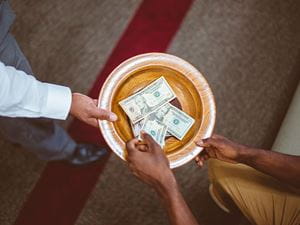
If you grew up going to church, you should remember the passing of the offering plate. You might not have questioned the effectiveness or validity of the practice, but you knew it was something churches did. Before the pandemic, most churches passed an offering plate or something equivalent. Now most churches have stopped the practice suddenly and starkly.
The offering plate is vanishing. One poll asked churchgoers if their church still passed around an offering plate, and the results were profound and clear. Seven out of ten churches don’t pass an offering plate anymore. The selection and sample size of the poll wouldn’t pass scientific demands, but the numbers are telling.
The origin of passing the offering plate.
As the soloist sings and instrumentalists play while ushers file down the aisle, churchgoers give money as an act of worship and to support the church’s ministry. If people don’t contribute, the pastor doesn’t get paid, buildings don’t get built, and missionaries don’t go on trips. When Christians attend church, most expect to pass the offering plate as much as they assume there will be singing, preaching, and prayer.
However, unlike prayer, singing, and preaching, the offering plate didn’t become an American worship service fixture until late in the 19th century. In colonial America, churches didn’t depend on weekly, voluntary giving from their members. Instead, like in Europe, the government established churches, permitting specific congregations and financially supporting them. Most New England colonies founded congregational churches, while southern colonies, New Jersey, Maryland, and New York, created the Anglican church. Most colonies couldn’t imagine a state without a church.
A thriving society depended on having citizens with good character, and the people expected churches to make moral citizens. Since churches served the greater good, funding them through fees and public taxes, like property and poll taxes, made sense instead of asking for offerings. Public funding for American churches didn’t stop immediately after the Revolutionary War. The First Amendment’s Establishment Clause stopped Congress from creating a national church, but the states still upheld churches through taxes.
After the Revolutionary War, men like James Madison, Thomas Jefferson, and John Leland fought against a religious establishment in Virginia. At the same time, Isaac Backus and other Baptist ministers led the same charge in New England. When Massachusetts rescinded its religious tax in 1833, every state church in the Union officially disbanded.
Instead of analyzing the reasons for the offering plate’s disappearance, we’ll explore the consequences of this shift. There’s more to this change than removing a traditional piece of a worship service. This change is significant. Here are some reasons why the vanishing offering plate is so substantial.
Most churches offer online giving.
When the pandemic affected the fact that most churches wouldn’t be open, there weren’t any worship services to pass around the offering plate. Churches that didn’t think about online giving made the change in a figurative blink of an eye. This shift isn’t minor. It means that church leaders must continuously guide members to digital giving as their means of stewardship. The offering plate is a visual reminder to give generously, and now that void must be filled.
The offering plate showed that giving is an act of worship.
Undoubtedly, this is the most often connected justification of what’s left of churches that still pass offering plates during worship. Now, church leaders must communicate and find ways to remind church members that giving is part of worship. Several churches have a stewardship generosity time during their worship services.
The offering plate isn’t coming back.
Some churches have resumed pre-pandemic practices, but passing the offering plate isn’t likely to return. Once church members start giving online, they’re unlikely to change their actions, and leaders see that giving online is more trustworthy. If a church member is out or a worship service is canceled, online giving means the funding doesn’t stop.
Millennials and Gen Z don’t like the offering plate.
This statement may only be based on anecdotal research, but scientific studies will confirm these observations. Millennials aren’t comfortable touching a plate that so many others have touched, and Gen Z will altogether avoid it.
The vanishing offering plate allows churches to rethink worship services.
The offering might be the most visible change in worship services, but it would serve church leaders to question other aspects or elements of the services. What are we doing because that’s tradition? What can we change, and what do we consider a non-negotiable that can’t change?
Should churches stop passing offering plates?
Some may question whether it’s necessary to pass the offering plate anymore. It’s essential to teach generosity to the public, but it should be done in a way that makes sense. Some churches already realize how digital giving can revitalize offerings, and it prepares them for the inevitable change in how people manage their finances. One of the most general criticisms against the church is that it only cares about money. This opinion is reinforced by numerous stories of abused and misused church finances, but taking offerings doesn’t help.
In every church service, passing the offering plate is a ten-minute window. It emphasizes people putting checks and money into bags, baskets, and plates passed throughout the sanctuary. It’s a practice that people outside the church don’t truly understand, feeding their suspicion that religion is a scam intended to take money from people. Mobile giving can solve this because when you train people to give through online giving, you remove an element that people link with profiteering, enabling you to focus on Jesus.
There are also some security issues that come with handling checks and cash. A handful of people have to count it as a group and put it in a safe. Then, the treasurer comes, rehandles it and makes the deposit. Any method that automates fund transfers from one account to another will solve this issue, including text-to-give and direct deposits.
Everything happened so quickly. Over 90 percent of churches won’t pass an offering plate at some point. The change is sudden and profound. Other changes are also taking place, like the “stand and greet” time in worship services.

